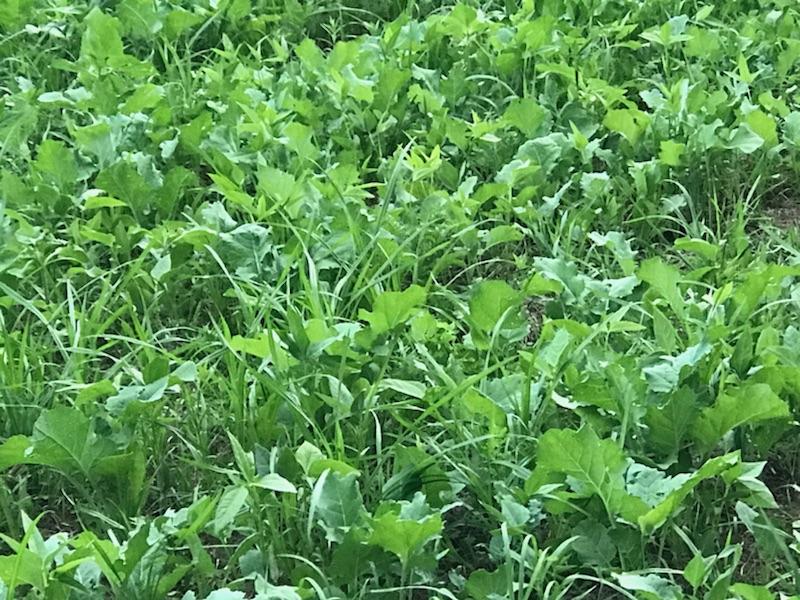Fertilizing Deer Food Plots

While reading the comments on a youtube video I made about how to interpret soil test reports from the PSU soils lab, I can see that there is a lot of mystery and confusion around the subject. A search of the subject brings up a lot of “simple remedy” ideas about just throwing on some fertilizer. Fertilizing deer food plots doesn’t have to be confusing.
A food plot should always be fertilized according to a soil test report that was made for the plants you intend to plant.
Soil Nutrients and What They Do
First, it’s important to understand the nutrients that are in the fertilizers you buy and why your plants need them to thrive and attract deer.
There are a couple of hundred elements found in soils and used by plants in various amounts. Some are simply catalysts for reactions within the plant, some are used as constituents in plant structures and some are used in the plant’s cell chemical functions and growth.
Usually, when we are discussing fertilizers we are discussing macronutrients – Nitrogen, Phosphorous and Potassium, NPK. These are available in chemical formulations that can be added when there are not quite enough in the soil to produce healthy plants. Most of the plants we put in farm fields or food plots are not native to the soils we are planting and therefor will not thrive without help.
One thing that is important to consider is that any plant is made up of mostly carbon, oxygen, hydrogen, in other words, water, sunshine and air. When you burn plants, the ash that is left is 5%-10% of the original plant volume – the minerals taken up by the plant. The main reason nutrients are necessary is for the growth and function of the plant organism.
What are the Numbers on a Bag of Fertilizer
The big three nutrients provided in commercial fertilizer are Nitrogen (N) Phosphorous (P) Potassium (K). The numbers are the ratios in percentages so a bag of 9-23-30 contains 9% N, 23% P and 30% K or 9, 23, 30 lbs of the elements per 100 lbs of fertilizer. Phosphorous and Potassium do not exist as pure elements but are in various forms such as ammonium phosphate and K could be in the form of Potassium Sulfate or Chloride.
Fertilizer elements are in the form of salts, defined as a strong acid combined with a strong base – lime is a salt, calcium carbonate, as is Potassium Sulfate.
Nitrogen
Nitrogen is the most abundant nutrient required for plant growth. The most noticeable symptoms of shortages show in plants and plants respond dramatically to correction. Nitrogen exists in different forms. Nitrate (NO3) or Ammonium (NH4).
Every acre of land has an atmosphere above it that contains 78% nitrogen gas or 30,000 tons of N2.
Nitrogen is a key component of protein and therefor chlorophyll. Interesting to note that a chlorophyll atom (and you know how important that molecule is) is made of a magnesium molecule surrounded by nitrogen, carbon, oxygen, hydrogen, sulfur and iron. Notice all of these macro and micro nutrients in Chlorophyll, which as you know, is the molecule that takes sunlight and makes carbohydrates from CO2 and H2O.
However, Nitrogen and Phosphorous are major pollutants when over-used. Excessive N causes health issues in animals and the environment. To quote Brunetti in the book The Farm as Ecosystem
“The mismanagement of Nitrogen is the single largest agriculturally destructive practice. It burns out humus, leaches calcium, acidifies the soil, contaminates ground and surface water and produces nitrous oxide, the most potent greenhouse gas, which then returns as nitric acid and destroys our forests by killing symbiotic fungi living amongst the trees’ roots.”
So, don’t think that if some N is good, lots more of it is better. Thats why I cringe when I see guys on the internet recommending fertilizing without a soil test. For one thing, its a waste of money and can be harmful to the environment.
Plants take up N is the forms of ammonium, nitrate and organic N. NO3 is the form that can leach out of the soil into the environment. Ammonium (NH4) is taken up by roots and used to construct proteins in the plant. This amino acid synthesis is fueled by carbohydrates produced by photosynthesis in the leaves. Energy sent to the roots also feeds microbes who are turning the NH4 into nitrates NO3 and forms useable by plants, so there is a symbiotic relationship there that needs to be protected. Soil microbiology, warmth, moisture are all critical for the system to function. You can see that this process releases Hydrogen ions which is acidity around the plant roots which helps with the uptake of trace minerals and keeps pathogens out. This acidifying effect aids in the uptake of phosphorus since it exists in the rock.
Plants dying and rotting in the soil are digested by microbes into amines (NH2) and ammonium (NH4) which are used for amino acids in the growing plants to make proteins. This process that is the natural system in the soil can be simulated by using cover crops and keeping plant residue and microbes (organic matter) in the soil.
Nitrogen fertilizer, however is converted to unstable ammonia gas and it lost to the atmosphere. So urea fertilizer really should be incorporated to prevent this. Calcium and Sulfer need to be present in order to create complete proteins. So you can see that all nutrients need to be present and balanced correctly.
Sources of Nitrogen Fertilizer
Ammonium Sulfate 21-00-24S
Monammonium Phosphate 11-52-0
Diammonium Phosphate 18-46-0
Ammonium Nitrate 34-0-0
Urea – 46-0-0
There are more, but manure is another good source 3% N
Phosphorus
P should be up around 350 lbs per acre or 80 ppm in the form of P2O5.
P supplies energy in the plant. It is critical for photosynthesis. ATP is a phosphate that is the energy currency of the cell and is used in protein synthesis.
Functions of P in the plant include: cell membranes, photosyntheseis DNA syntesis, flowering, fruiting, seed production, nitrogen fixation, root growth , stalk strength. For us deer producers, phosphorus is used to build bones (antlers) and teeth.
Sources of Phosphorus
Superphosphate 0-20-20
Triple superphosphate 0-46-0
DAP – 18-46-0
MAP – 11-52-0
rock phosphate
bird quano
sewage sludge
Most are made from phosphate rock mined abroad.
Potassium
K is a cation and will show up in the cation part of your soil test report. It should be up near 5% of the Base Saturation.
K is a real workhorse and is involved in temperature regulation, disease resistence, water uptake and regulation, protein synthesis, carbohytrate synthesis, is a catalyst for many chemical reactions within the plant.
Much of the potassium in soil is locked up and not available to plants. The exchangeable cations are attached to the soil particles and that is what shows up on the test report. This may be 1% of total K in soil. Rember where Calcium helps break up clay particles? Adequate Ca helps release K from clay particles. Perennials like clovers are better at getting K out of the soil since their roots are in the soil longer and can use plant exudates to extract it. If Ca and Mg base saturations add up to 90%. Sodium, another cation that shows up in base saturation percentage can interfere with availability of K as well.
Plants high in protein and carbs need a lot of K (food plot plants.)
Two Nutrients That are Not in a Bag of Fertilizer but are Just as Important are Calcium and Sulfer
Calcium
Calcium is the backbone of fertility. It is one of the cations or positively charged ions that cling to negatively charged soil particles. The base saturation percentage (shown on your soil test) should be up around 70%. In other words most of the spots on the soil particle for anions to attach should be Ca+. Calcium helps with uptake of nutrients, improves soil texture (breaks up clays), increases the availability of trace elements and lots of other stuff within the plant, including root development, cellular integrity.
Calcium is available usually in Limestone. Hi calcium limestone has 35% Ca and dolomitic liemstone is 21% Ca and 12% Magnesium. If Mg is needed in your soil test you will want to apply dolomitic limestone.
Gypsum is 22% Ca and 19% sulfur so is a great choice if you need sulfer according to your micronutrient levels in the soil test.
Paper mill sludge is another great source and can sometimes be a very inexpensive product is 35% Ca and highly reactive.
Aragonite is calcium from sea water and is 35% Ca
Sulfur
Sulfur is a micronutrient that will show up on your test report and should be at least 50 ppm. It is the 4th major nutrient after NPK. Sulfur is a constituent of protein molecules. It is necessary for N fixation, is part of chlorophyll, vitamins and enzymes. According to Brunetti, it is the second most important limiting nutrient after nitrogen.
Manure is an excellent source of sulfur and is well balanced with nitrogen in that source. Crop residues, or “green manure” are also good.
Gypsum as shown above is calcium sulfate so can offer a great source of both important nutrients. Ammonium sulfate is great to provide Nitrogen and Sulfur.
How to Fertilize a Deer Food Plot
- get a soil test
- understand the test report – check out my Youtube channel for good info on how to interpret a soil test – there is a list of food plot videos.
- Find a knowledgeable source of fertilizer products – this will be a farm service company such as Growmark or Helena
- Get the soil amendments on in the correct amounts
Here are some links to books I recommend to educate yourself on soil fertility:

